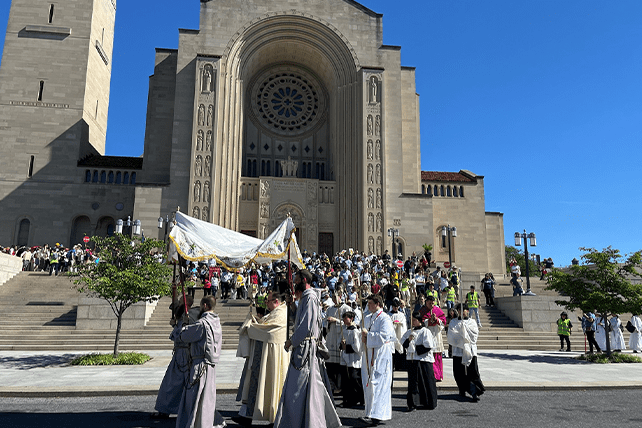WASHINGTON (RNS) — On her 22nd day traveling across the United States, Natalie Garza broke off from the Eucharistic procession, bounded up the front steps of a Washington, D.C., home and handed an onlooker a card stamped with a QR code that would explain why a crowd of hundreds of Catholics like Garza had filled the street outside his home in the Brookland neighborhood of the nation’s capital.
Since May 17, the National Eucharistic Pilgrimage, a cross-shaped trek along four routes across the U.S., has been heading for Indianapolis, where tens of thousands of faithful are expected to take part in the National Eucharistic Congress, a five-day event aimed at increasing devotion to the sacrament at the heart of Catholic life. The congress will be a culmination of two years of diocesan and parish level programming, including more opportunities for adoration of the Blessed Sacrament.
Both the pilgrimage and congress are part of the National Eucharistic Revival, a three-year initiative launched by the U.S. bishops’ conference to educate Catholics about the Eucharist. Catholic doctrine teaches that Jesus is actually present in the bread and wine of the Eucharist, as opposed to some Protestant denominations that consider the Eucharist to be a commemoration of Jesus’ death and resurrection.
While most Catholics in the D.C. procession had joined the procession only for the day, Garza, a high school theology teacher at St. James Academy in Lenexa, Kansas, is one of six young adults, known as perpetual pilgrims, traveling the entirety of the pilgrimage’s St. Elizabeth Ann Seton route, walking 10 to 20 miles most days on the way from New Haven, Connecticut, to Indianapolis.
Garza, an alumna of Franciscan University of Steubenville, Ohio, said she was inspired to apply to be a perpetual pilgrim because she wanted to increase in her “lived experience of discipleship.”
“I knew that this was going to be one of the greatest movements in the American church up until this time, and I wanted to be a part of that. I wanted to walk with Jesus to intercede for America,” said Garza, who compared her pilgrimage experience to the life of the apostles.
Her hope, she said, was that the revival would bring Catholics in greater numbers to vocations to the priesthood as well as to married life. “I hope that this revival brings a renewed sense for all people that God desires them, and he will do anything to be with them,” she said.
In 2019, a Pew Research Center survey found that only 31% of U.S. Catholics believed in Catholic teaching about the real presence of Jesus in the Eucharist, raising alarm among bishops, but also drawing criticism from theologians and other pollsters who said the poll’s wording had likely skewed the data.
Along with concerns about flawed polling, the National Eucharistic Revival has faced criticism for drawing resources and attention from Pope Francis’ major consultative initiative, the Synod on Synodality, as well as for the revival’s $14 million cost and its often tchotchke-based brand of piety.
Subsequent polling in 2022 from Georgetown University’s Center for Applied Research in the Apostolate found that, while there was substantial confusion about Catholic teaching on the Eucharist and Catholic respondents did not consistently answer questions in line with Catholic doctrine, 64% did indicate that they believe in the real presence of Jesus in the Eucharist.
That same 2022 poll found that only 17% of U.S. adult Catholics were attending Mass weekly, part of a trend of decreased Mass attendance since the beginning of the COVID-19 pandemic.

